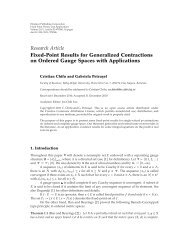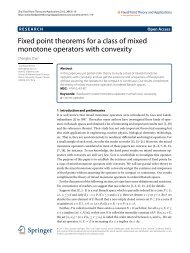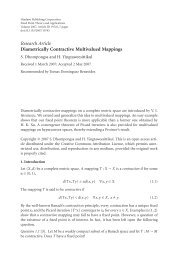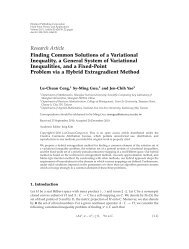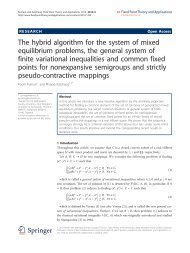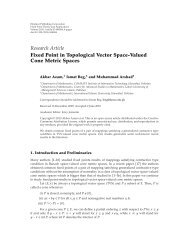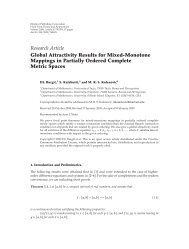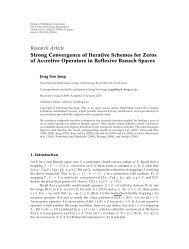Fixed points of multivalued nonexpansive mappings in Banach spaces
Fixed points of multivalued nonexpansive mappings in Banach spaces
Fixed points of multivalued nonexpansive mappings in Banach spaces
Create successful ePaper yourself
Turn your PDF publications into a flip-book with our unique Google optimized e-Paper software.
Khan and Yildirim <strong>Fixed</strong> Po<strong>in</strong>t Theory and Applications 2012, 2012:73<br />
http://www.fixedpo<strong>in</strong>ttheoryandapplications.com/content/2012/1/73<br />
RESEARCH Open Access<br />
<strong>Fixed</strong> <strong>po<strong>in</strong>ts</strong> <strong>of</strong> <strong>multivalued</strong> <strong>nonexpansive</strong><br />
<strong>mapp<strong>in</strong>gs</strong> <strong>in</strong> <strong>Banach</strong> <strong>spaces</strong><br />
Safeer Hussa<strong>in</strong> Khan 1 and Isa Yildirim 2*<br />
* Correspondence:<br />
isayildirim@atauni.edu.tr<br />
2 Department <strong>of</strong> Mathematics,<br />
Ataturk University, Erzurum 25240,<br />
Turkey<br />
Full list <strong>of</strong> author <strong>in</strong>formation is<br />
available at the end <strong>of</strong> the article<br />
Abstract<br />
In this article, we first give a <strong>multivalued</strong> version <strong>of</strong> an iteration scheme <strong>of</strong> Agarwal<br />
et al. We use an idea due to Shahzad and Zegeye which removes a “strong<br />
condition” on the mapp<strong>in</strong>g <strong>in</strong>volved <strong>in</strong> the iteration scheme and an observation by<br />
Song and Cho about the set <strong>of</strong> fixed <strong>po<strong>in</strong>ts</strong> <strong>of</strong> that mapp<strong>in</strong>g. In this way, we<br />
approximate fixed <strong>po<strong>in</strong>ts</strong> <strong>of</strong> a <strong>multivalued</strong> <strong>nonexpansive</strong> mapp<strong>in</strong>g through an<br />
iteration scheme which is <strong>in</strong>dependent <strong>of</strong> but faster than Ishikawa scheme used<br />
both by Song and Cho, and Shahzad and Zegeye. Thus our results improve and<br />
unify correspond<strong>in</strong>g results <strong>in</strong> the contemporary literature.<br />
Mathematics Subject Classification (2000): 47H10; 54H25.<br />
Keywords: <strong>multivalued</strong> <strong>nonexpansive</strong> mapp<strong>in</strong>g, common fixed po<strong>in</strong>t, condition (I),<br />
weak and strong convergence<br />
1. Introduction and prelim<strong>in</strong>aries<br />
Throughout the article, N denotes the set <strong>of</strong> positive <strong>in</strong>tegers. Let E be a real <strong>Banach</strong><br />
space. A subset K is called proxim<strong>in</strong>al if for each x Î E, there exists an element k Î K<br />
such that<br />
d(x, k) =<strong>in</strong>f{||x − y|| : y ∈ K} = d(x, K)<br />
It is known that a weakly compact convex subsets <strong>of</strong> a <strong>Banach</strong> space and closed convex<br />
subsets <strong>of</strong> a uniformly convex <strong>Banach</strong> space are proxim<strong>in</strong>al. We shall denote the<br />
family <strong>of</strong> nonempty bounded proxim<strong>in</strong>al subsets <strong>of</strong> K by P(K). Consistent with [1], let<br />
CB(K) be the class <strong>of</strong> all nonempty bounded and closed subsets <strong>of</strong> K. Let H be a Hausdorff<br />
metric <strong>in</strong>duced by the metric d <strong>of</strong> E, that is<br />
H(A, B) =max{sup<br />
x∈A<br />
d(x, B), sup d(y, A)}<br />
y∈B<br />
for every A, B Î CB(E). A <strong>multivalued</strong> mapp<strong>in</strong>g T : K ® P (K) issaidtobeacontraction<br />
if there exists a constant k Î [0, 1) such that for any x, y Î K,<br />
H(Tx, Ty) ≤ k||x − y||,<br />
and T is said to be <strong>nonexpansive</strong> if<br />
H(Tx, Ty) ≤ ||x − y||<br />
for all x, y Î K. A po<strong>in</strong>t x Î K is called a fixed po<strong>in</strong>t <strong>of</strong> T if x Î Tx.<br />
© 2012 Khan and Yildirim; licensee Spr<strong>in</strong>ger. This is an Open Access article distributed under the terms <strong>of</strong> the Creative Commons<br />
Attribution License (http://creativecommons.org/licenses/by/2.0), which permits unrestricted use, distribution, and reproduction <strong>in</strong><br />
any medium, provided the orig<strong>in</strong>al work is properly cited.
Khan and Yildirim <strong>Fixed</strong> Po<strong>in</strong>t Theory and Applications 2012, 2012:73<br />
http://www.fixedpo<strong>in</strong>ttheoryandapplications.com/content/2012/1/73<br />
The study <strong>of</strong> fixed <strong>po<strong>in</strong>ts</strong> for <strong>multivalued</strong> contractions and <strong>nonexpansive</strong> <strong>mapp<strong>in</strong>gs</strong><br />
us<strong>in</strong>g the Hausdorff metric was <strong>in</strong>itiated by Mark<strong>in</strong> [2] (see also [1]). Later, an <strong>in</strong>terest<strong>in</strong>g<br />
and rich fixed po<strong>in</strong>t theory for such maps was developed which has applications <strong>in</strong><br />
control theory, convex optimization, differential <strong>in</strong>clusion, and economics (see, [3] and<br />
references cited there<strong>in</strong>). Moreover, the existence <strong>of</strong> fixed <strong>po<strong>in</strong>ts</strong> for <strong>multivalued</strong> <strong>nonexpansive</strong><br />
<strong>mapp<strong>in</strong>gs</strong> <strong>in</strong> uniformly convex <strong>Banach</strong> <strong>spaces</strong> was proved by Lim [4].<br />
The theory <strong>of</strong> <strong>multivalued</strong> <strong>nonexpansive</strong> <strong>mapp<strong>in</strong>gs</strong> is harder than the correspond<strong>in</strong>g<br />
theory <strong>of</strong> s<strong>in</strong>gle valued <strong>nonexpansive</strong> <strong>mapp<strong>in</strong>gs</strong>. Different iterative processes have been<br />
used to approximate the fixed <strong>po<strong>in</strong>ts</strong> <strong>of</strong> <strong>multivalued</strong> <strong>nonexpansive</strong> <strong>mapp<strong>in</strong>gs</strong>. Among<br />
these iterative processes, Sastry and Babu [5] considered the follow<strong>in</strong>g.<br />
Let K beanonemptyconvexsubset<strong>of</strong>E, T : K ® P(K) a <strong>multivalued</strong> mapp<strong>in</strong>g with<br />
p Î Tp.<br />
(i) The sequences <strong>of</strong> Mann iterates is def<strong>in</strong>ed by x1 Î K,<br />
xn+1 =(1− an)xn + anyn, (1:1)<br />
where yn Î Txn is such that ||yn -p|| = d(p, Txn), and {an} is a sequence <strong>of</strong> numbers<br />
<strong>in</strong> (0, 1) satisfy<strong>in</strong>g lim an =0and<br />
n→∞ an = ∞.<br />
(ii) The sequence <strong>of</strong> Ishikawa iterates is def<strong>in</strong>ed by x1 Î K,<br />
<br />
yn =(1−bn)xn + bnzn,<br />
(1:2)<br />
xn+1 =(1−an)xn + anun,<br />
where zn Î Txn,un Î Tyn are such that ||zn -p|| = d(p, Txn)and||un-p|| = d(p,<br />
Tyn), and {an}, {bn} are real sequences <strong>of</strong> numbers with 0 ≤ an, bn 0, then there exists b Î Bsuchthatd<br />
(a, b) ≤ H(A, B) +h.<br />
Based on the above Lemma, Song and Wang [7] modified the iteration scheme due<br />
to Panyanak [6] and improved the results presented there<strong>in</strong>. Their scheme is given as<br />
follows:<br />
Let K be a nonempty convex subset <strong>of</strong> E, an Î [0, 1], bn Î [0, 1] and hn Î (0, ∞)<br />
such that limn ® ∞hn = 0. Choose x1 Î K and z1 Î Tx1. Let<br />
y1 =(1− b1)x1 + b1z1.<br />
Choose u 1 Î Ty 1 such that || z 1 -u 1 || ≤ H(Tx 1, Ty 1)+h 1 (see [1,8]). Let<br />
x2 =(1− a1)x1 + a1u1.<br />
Choose z 2 Î Tx 2 such that || z 2 -u 1 || ≤ H(Tx 2, Ty 1)+h 2. Take<br />
y2 =(1− b2)x2 + b2z2.<br />
Choose u 2 Î Ty 2 such that || z 2 -u 2 || ≤ H(Tx 2, Ty 2)+h 2. Let<br />
x3 =(1− a2)x2 + a2u2.<br />
Page 2 <strong>of</strong> 9
Khan and Yildirim <strong>Fixed</strong> Po<strong>in</strong>t Theory and Applications 2012, 2012:73<br />
http://www.fixedpo<strong>in</strong>ttheoryandapplications.com/content/2012/1/73<br />
Inductively, we have<br />
yn =(1− bn)xn + bnzn<br />
xn+1 =(1− an)xn + anun<br />
(1:3)<br />
where z n Î Tx n,u n Î Ty n are such that ||z n -u n|| ≤ H(Tx n,Ty n)+h n and ||z n+1<br />
-u n|| ≤ H(Tx n+1, Ty n)+h n,and{a n},{b n} are real sequences <strong>of</strong> numbers with 0 ≤ a n,<br />
bn
Khan and Yildirim <strong>Fixed</strong> Po<strong>in</strong>t Theory and Applications 2012, 2012:73<br />
http://www.fixedpo<strong>in</strong>ttheoryandapplications.com/content/2012/1/73<br />
where v n Î P T(x n), u n Î P T(y n) and 0 < l, h
Khan and Yildirim <strong>Fixed</strong> Po<strong>in</strong>t Theory and Applications 2012, 2012:73<br />
http://www.fixedpo<strong>in</strong>ttheoryandapplications.com/content/2012/1/73<br />
But<br />
||yn − p|| = ||(1 − η)xn + ηvn − p||<br />
Thus (2.1) becomes<br />
≤ (1 − η)||xn − p|| + η||vn − p||<br />
≤ (1 − η)||xn − p|| + ηH(PT(xn), PT(p))<br />
≤ (1 − η)||xn − p|| + η||xn − p||<br />
= ||xn − p||.<br />
||xn+1 − p|| ≤ (1 − λ)||xn − p|| + λ||xn − p||<br />
= ||xn − p||,<br />
(2:2)<br />
and limn® ∞ ||xn -p|| exists for each p Î F (T). □<br />
Lemma 5. Let E be a uniformly convex <strong>Banach</strong> space and K be a nonempty closed<br />
convex subset <strong>of</strong> E. Let T : K ® P(K) be a <strong>multivalued</strong> mapp<strong>in</strong>g such that F(T) ≠ ∅<br />
and P T is a <strong>nonexpansive</strong> mapp<strong>in</strong>g. Let {x n} be the sequence as def<strong>in</strong>ed <strong>in</strong> (1.5). Then<br />
lim<br />
n→∞ d(xn, Txn) =0.<br />
Pro<strong>of</strong>. FromLemma4, lim<br />
n→∞ ||xn − p|| exists for each p Î F (T). We suppose that<br />
lim<br />
n→∞ ||xn − p|| = c for some c ≥ 0.<br />
S<strong>in</strong>ce lim sup n® ∞ ||v n -p|| ≤ lim sup n® ∞ H (P T (x n), P T (p)) ≤ lim sup n® ∞ || x n -<br />
p || = c,<br />
so<br />
Similarly,<br />
lim sup ||vn − p|| ≤ c. (2:3)<br />
n→∞<br />
lim sup ||un − p|| ≤ c.<br />
n→∞<br />
Apply<strong>in</strong>g Lemma 3, we get<br />
lim<br />
n→∞ ||vn − un|| =0.<br />
Tak<strong>in</strong>g lim sup on both sides <strong>of</strong> (2.2), we obta<strong>in</strong><br />
Also<br />
lim sup ||yn − p|| ≤ c. (2:4)<br />
n→∞<br />
||xn+1 − p|| = ||(1 − λ)vn + λun − p||<br />
implies that<br />
= ||(vn − p)+λ(un − vn)||<br />
≤||vn − p|| + ||vn − un||<br />
c ≤ lim <strong>in</strong>f||vn − p||. (2:5)<br />
Comb<strong>in</strong><strong>in</strong>g (2.3) and (2.5), we have<br />
lim<br />
n→∞ ||vn − p|| = c.<br />
Page 5 <strong>of</strong> 9
Khan and Yildirim <strong>Fixed</strong> Po<strong>in</strong>t Theory and Applications 2012, 2012:73<br />
http://www.fixedpo<strong>in</strong>ttheoryandapplications.com/content/2012/1/73<br />
Thus<br />
gives<br />
||vn − p|| ≤ ||vn − un|| + ||un − p||<br />
≤||vn − un|| + H(PT(yn), PT(p))<br />
≤||vn − un|| + ||yn − p||<br />
c ≤ lim <strong>in</strong>f||yn − p|| (2:6)<br />
and, <strong>in</strong> turn, by (2.4), we have<br />
lim<br />
n→∞ ||yn − p|| = c.<br />
Apply<strong>in</strong>g Lemma 3 once aga<strong>in</strong>,<br />
lim<br />
n→∞ ||xn − vn|| =0. (2:7)<br />
S<strong>in</strong>ce d(x n,Tx n) ≤ ||x n -v n||, we have<br />
lim<br />
n→∞ d(xn, Txn) =0.<br />
□<br />
Now we approximate fixed <strong>po<strong>in</strong>ts</strong> <strong>of</strong> the mapp<strong>in</strong>g T through weak convergence <strong>of</strong><br />
the sequence {x n} def<strong>in</strong>ed <strong>in</strong> (1.5).<br />
Theorem 1. Let E be a uniformly convex <strong>Banach</strong> space satisfy<strong>in</strong>g Opial’s condition<br />
and K a nonempty closed convex subset <strong>of</strong> E. Let T : K ® P(K) be a <strong>multivalued</strong> mapp<strong>in</strong>g<br />
such that F(T) ≠ ∅ and PT is a <strong>nonexpansive</strong> mapp<strong>in</strong>g. Let {xn} be the sequence as<br />
def<strong>in</strong>ed <strong>in</strong> (1.5). Let I - PT be demiclosed with respect to zero, then {xn} converges weakly<br />
to a fixed po<strong>in</strong>t <strong>of</strong> T.<br />
Pro<strong>of</strong>. Letp Î F(T) =F(P T). From the pro<strong>of</strong> <strong>of</strong> Lemma 4, lim<br />
n→∞ ||xn − p|| exists. Now<br />
we prove that {x n} has a unique weak subsequential limit <strong>in</strong> F(T). To prove this, let z 1<br />
and z 2 be weak limits <strong>of</strong> the subsequences {xni } and {xnj } <strong>of</strong> {x n}, respectively. By (2.7),<br />
there exists vn Î Txn such that lim<br />
n→∞ ||xn − vn|| =0.S<strong>in</strong>ceI-PT is demiclosed with<br />
respect to zero, therefore we obta<strong>in</strong> z1 Î F(PT )=F(T). In the same way, we can prove<br />
that z 2 Î F(T).<br />
Next, we prove uniqueness. For this, suppose that z 1 ≠ z 2. Then by Opial’s condition,<br />
we have<br />
lim<br />
n→∞ ||xn − z1|| = lim ||xni − z1||<br />
ni→∞<br />
< lim ||xni − z2||<br />
ni→∞<br />
= lim ||xn − z2||<br />
n→∞<br />
= lim ||xnj − z2||<br />
nj→∞<br />
< lim ||xnj − z1||<br />
nj→∞<br />
= lim<br />
n→∞ ||xn − z1||,<br />
which is a contradiction. Hence {x n} converges weakly to a po<strong>in</strong>t <strong>in</strong> F(T). □<br />
Page 6 <strong>of</strong> 9
Khan and Yildirim <strong>Fixed</strong> Po<strong>in</strong>t Theory and Applications 2012, 2012:73<br />
http://www.fixedpo<strong>in</strong>ttheoryandapplications.com/content/2012/1/73<br />
We now give some strong convergence theorems. Our first strong convergence theorem<br />
is valid <strong>in</strong> general real <strong>Banach</strong> <strong>spaces</strong>. We then apply this theorem to obta<strong>in</strong> a<br />
result <strong>in</strong> uniformly convex <strong>Banach</strong> <strong>spaces</strong>. We also use the method <strong>of</strong> direct construction<br />
<strong>of</strong> Cauchy sequence as <strong>in</strong>dicated by Song and Cho [13] (and opposed to [10]) but<br />
used also by many other authors <strong>in</strong>clud<strong>in</strong>g [12,14,15].<br />
Theorem 2. Let E be a real <strong>Banach</strong> space and K a nonempty closed convex subset <strong>of</strong><br />
E. Let T : K ® P(K) be a <strong>multivalued</strong> mapp<strong>in</strong>g such that F(T) ≠ ∅ and P T is a <strong>nonexpansive</strong><br />
mapp<strong>in</strong>g. Let {xn} be the sequence as def<strong>in</strong>ed <strong>in</strong> (1.5), then {xn} converges<br />
strongly to a po<strong>in</strong>t <strong>of</strong> F(T) if and only if lim <strong>in</strong>f n® ∞d(x n,F(T)) = 0.<br />
Pro<strong>of</strong>. The necessity is obvious. Conversely, suppose that lim <strong>in</strong>f n® ∞d(x n,F(T)) = 0.<br />
As proved <strong>in</strong> Lemma 4, we have<br />
||xn+1 − p|| ≤ ||xn − p||,<br />
which gives<br />
d(xn+1, F(T)) ≤ d(xn, F(T)).<br />
This implies that lim d(xn, F(T)) exists and so by the hypothesis,<br />
n→∞<br />
lim <strong>in</strong>f<br />
n→∞ d(xn, F(T)) = 0. Therefore we must have lim d(xn, F(T)) = 0.<br />
n→∞<br />
Next, we show that {xn} is a Cauchy sequence <strong>in</strong> K. Letε >0 be arbitrarily chosen.<br />
S<strong>in</strong>ce lim<br />
n→∞ d(xn, F(T)) = 0., there exists a constant n 0 such that for all n ≥ n 0, we have<br />
d(xn, F(T)) < ε<br />
4 .<br />
ε<br />
In particular, <strong>in</strong>f{||xn0 − p|| : p ∈ F(T)} < . There must exist a p* Î F(T) such that<br />
4<br />
||xn0 − p∗ || < ε<br />
2 .<br />
Now for m, n ≥ n0, we have<br />
||xn+m − xn|| ≤ ||xn+m − p ∗ || + ||xn − p ∗ ||<br />
≤ 2||xn0 − p∗ ||<br />
ε <br />
< 2 = ε.<br />
2<br />
Hence {xn} is a Cauchy sequence <strong>in</strong> a closed subset K <strong>of</strong> a <strong>Banach</strong> space E, andsoit<br />
must converge <strong>in</strong> K. Let lim xn = q . Now<br />
n→∞<br />
d(q, PTq) ≤ ||xn−q|| + d(xn, PTxn)+H(PTxn, PTq)<br />
≤ ||xn−q|| + ||xn − vn|| + ||xn − q||<br />
→ 0asn →∞<br />
which gives that d(q, PTq) = 0. But PT is a <strong>nonexpansive</strong> mapp<strong>in</strong>g so F(PT) is closed.<br />
Therefore, q Î F(PT) =F(T). □<br />
We now apply the above theorem to obta<strong>in</strong> the follow<strong>in</strong>g theorem <strong>in</strong> uniformly convex<br />
<strong>Banach</strong> <strong>spaces</strong> where T : K ® P (K) satisfies condition (I).<br />
Theorem 3. Let E be a uniformly convex <strong>Banach</strong> space and K a nonempty closed<br />
convex subset <strong>of</strong> E. Let T : K ® P (K) be a <strong>multivalued</strong> mapp<strong>in</strong>g satisfy<strong>in</strong>g condition (I)<br />
Page 7 <strong>of</strong> 9
Khan and Yildirim <strong>Fixed</strong> Po<strong>in</strong>t Theory and Applications 2012, 2012:73<br />
http://www.fixedpo<strong>in</strong>ttheoryandapplications.com/content/2012/1/73<br />
such that F(T ) ≠ ∅ and P T is a <strong>nonexpansive</strong> mapp<strong>in</strong>g. Let {x n} be the sequence as<br />
def<strong>in</strong>ed <strong>in</strong> (1.5), then {x n} converges strongly to a po<strong>in</strong>t <strong>of</strong> F(T).<br />
Pro<strong>of</strong>. ByLemma5,limn® ∞ ||xn -p|| exists for all p Î F(T). Let this limit be c for<br />
some c ≥ 0.<br />
If c = 0, there is noth<strong>in</strong>g to prove.<br />
Suppose c>0. Now ||x n+1-p|| ≤ ||x n -p|| implies that<br />
<strong>in</strong>f<br />
p∈F(T) ||xn+1 − p|| ≤ <strong>in</strong>f<br />
p∈F(T) ||xn − p||,<br />
which means that d(x n+1, F(T)) ≤ d(x n,F(T)) and so lim<br />
n→∞ d(xn, F(T)) exists. By us<strong>in</strong>g<br />
condition (I) and Lemma 5, we have<br />
That is,<br />
lim<br />
n→∞ f (d(xn, F(T))) ≤ lim d(xn, Txn) =0.<br />
n→∞<br />
lim<br />
n→∞ f (d(xn, F(T))) = 0.<br />
S<strong>in</strong>ce f is a nondecreas<strong>in</strong>g function and f(0) = 0, it follows that lim<br />
n→∞ d(xn, F(T)) = 0..<br />
Now apply<strong>in</strong>g Theorem 2, we obta<strong>in</strong> the result. □<br />
Author details<br />
1 Department <strong>of</strong> Mathematics, Statistics and Physics,Qatar University, Doha 2713, Qatar 2 Department <strong>of</strong> Mathematics,<br />
Ataturk University, Erzurum 25240, Turkey<br />
Authors’ contributions<br />
SHK gave the idea and wrote the <strong>in</strong>itial draft. IY read and agreed upon the draft. SHK then f<strong>in</strong>alized the manuscript.<br />
Correspondence was ma<strong>in</strong>ly done by IY. All authors read and approved the f<strong>in</strong>al manuscript.<br />
Compet<strong>in</strong>g <strong>in</strong>terests<br />
The authors declare that they have no compet<strong>in</strong>g <strong>in</strong>terests.<br />
Received: 26 September 2011 Accepted: 2 May 2012 Published: 2 May 2012<br />
References<br />
1. Nadler, SB Jr: Multivalued contraction <strong>mapp<strong>in</strong>gs</strong>. Pacific J Math. 30, 475–488 (1969)<br />
2. Mark<strong>in</strong>, JT: Cont<strong>in</strong>uous dependence <strong>of</strong> fixed po<strong>in</strong>t sets. Proc Am Math Soc. 38, 545–547 (1973)<br />
3. Gorniewicz, L: Topological fixed po<strong>in</strong>t theory <strong>of</strong> <strong>multivalued</strong> <strong>mapp<strong>in</strong>gs</strong>. Kluwer Academic Pub., Dordrecht, Netherlands<br />
(1999)<br />
4. Lim, TC: A fixed po<strong>in</strong>t theorem for <strong>multivalued</strong> <strong>nonexpansive</strong> <strong>mapp<strong>in</strong>gs</strong> <strong>in</strong> a uniformly convex <strong>Banach</strong> <strong>spaces</strong>. Bull Am<br />
Math Soc. 80, 1123–1126 (1974)<br />
5. Sastry, KPR, Babu, GVR: Convergence <strong>of</strong> Ishikawa iterates for a <strong>multivalued</strong> mapp<strong>in</strong>g with a fixed po<strong>in</strong>t. Czechoslovak<br />
Math J. 55, 817–826 (2005)<br />
6. Panyanak, B: Mann and Ishikawa iterative processes for <strong>multivalued</strong> <strong>mapp<strong>in</strong>gs</strong> <strong>in</strong> <strong>Banach</strong> <strong>spaces</strong>. Comp Math Appl. 54,<br />
872–877 (2007)<br />
7. Song, Y, Wang, H: Erratum to “Mann and Ishikawa iterative processes for <strong>multivalued</strong> <strong>mapp<strong>in</strong>gs</strong> <strong>in</strong> <strong>Banach</strong> <strong>spaces</strong>”<br />
[Comp. Math. Appl. 54, 872-877 (2007)]. Comp Math Appl. 55, 2999–3002 (2008)<br />
8. Assad, NA, Kirk, WA: <strong>Fixed</strong> po<strong>in</strong>t theorems for set-valued <strong>mapp<strong>in</strong>gs</strong> <strong>of</strong> contractive type. Pacific J Math. 43, 553–562<br />
(1972)<br />
9. Jung, JS: Strong convergence theorems for <strong>multivalued</strong> <strong>nonexpansive</strong> nonself <strong>mapp<strong>in</strong>gs</strong> <strong>in</strong> <strong>Banach</strong> <strong>spaces</strong>. Nonl<strong>in</strong>ear<br />
Anal. 66, 2345–2354 (2007)<br />
10. Shahzad, N, Zegeye, H: On Mann and Ishikawa iteration schemes for multi-valued maps <strong>in</strong> <strong>Banach</strong> <strong>spaces</strong>. Nonl<strong>in</strong>ear<br />
Anal. 71(3-4):838–844 (2009)<br />
11. Agarwal, RP, O’Regan, D, Sahu, DR: Iterative construction <strong>of</strong> fixed <strong>po<strong>in</strong>ts</strong> <strong>of</strong> nearly asymptotically <strong>nonexpansive</strong><br />
<strong>mapp<strong>in</strong>gs</strong>. J Nonl<strong>in</strong>ear Convex Anal. 8(1):61–79 (2007)<br />
12. Khan, SH, Kim, JK: Common fixed <strong>po<strong>in</strong>ts</strong> <strong>of</strong> two <strong>nonexpansive</strong> <strong>mapp<strong>in</strong>gs</strong> by a modified faster iteration scheme. Bull<br />
Korean Math Soc. 47(5):973–985 (2010)<br />
13. Song, Y, Cho, YJ: Some notes on Ishikawa iteration for <strong>multivalued</strong> <strong>mapp<strong>in</strong>gs</strong>. Bull Korean Math Soc 48(3):575–584<br />
(2011). doi:10.4134/BKMS.2011.48.3.575<br />
14. Khan, SH, Abbas, M, Rhoades, BE: A new one-step iterative scheme for approximat<strong>in</strong>g common fixed <strong>po<strong>in</strong>ts</strong> <strong>of</strong> two<br />
<strong>multivalued</strong> <strong>nonexpansive</strong> <strong>mapp<strong>in</strong>gs</strong>. Rend del Circ Mat. 59, 149–157 (2010)<br />
Page 8 <strong>of</strong> 9
Khan and Yildirim <strong>Fixed</strong> Po<strong>in</strong>t Theory and Applications 2012, 2012:73<br />
http://www.fixedpo<strong>in</strong>ttheoryandapplications.com/content/2012/1/73<br />
15. Khan, SH, Fukhar-ud-d<strong>in</strong>, H: Weak and strong convergence <strong>of</strong> a scheme with errors for two <strong>nonexpansive</strong> <strong>mapp<strong>in</strong>gs</strong>.<br />
Nonl<strong>in</strong>ear Anal. 8, 1295–1301 (2005)<br />
16. Opial, Z: Weak convergence <strong>of</strong> the sequence <strong>of</strong> successive approximations for <strong>nonexpansive</strong> <strong>mapp<strong>in</strong>gs</strong>. Bull Am Math<br />
Soc. 73, 591–597 (1967)<br />
17. Senter, HF, Dotson, WG: Approximatig fixed <strong>po<strong>in</strong>ts</strong> <strong>of</strong> <strong>nonexpansive</strong> <strong>mapp<strong>in</strong>gs</strong>. Proc Am Math Soc. 44(2):375–380 (1974)<br />
18. Schu, J: Weak and strong convergence to fixed <strong>po<strong>in</strong>ts</strong> <strong>of</strong> asymptotically <strong>nonexpansive</strong> <strong>mapp<strong>in</strong>gs</strong>. Bull Austral Math Soc.<br />
43, 153–159 (1991)<br />
doi:10.1186/1687-1812-2012-73<br />
Cite this article as: Khan and Yildirim: <strong>Fixed</strong> <strong>po<strong>in</strong>ts</strong> <strong>of</strong> <strong>multivalued</strong> <strong>nonexpansive</strong> <strong>mapp<strong>in</strong>gs</strong> <strong>in</strong> <strong>Banach</strong> <strong>spaces</strong>.<br />
<strong>Fixed</strong> Po<strong>in</strong>t Theory and Applications 2012 2012:73.<br />
Submit your manuscript to a<br />
journal and benefi t from:<br />
7 Convenient onl<strong>in</strong>e submission<br />
7 Rigorous peer review<br />
7 Immediate publication on acceptance<br />
7 Open access: articles freely available onl<strong>in</strong>e<br />
7 High visibility with<strong>in</strong> the fi eld<br />
7 Reta<strong>in</strong><strong>in</strong>g the copyright to your article<br />
Submit your next manuscript at 7 spr<strong>in</strong>geropen.com<br />
Page 9 <strong>of</strong> 9



